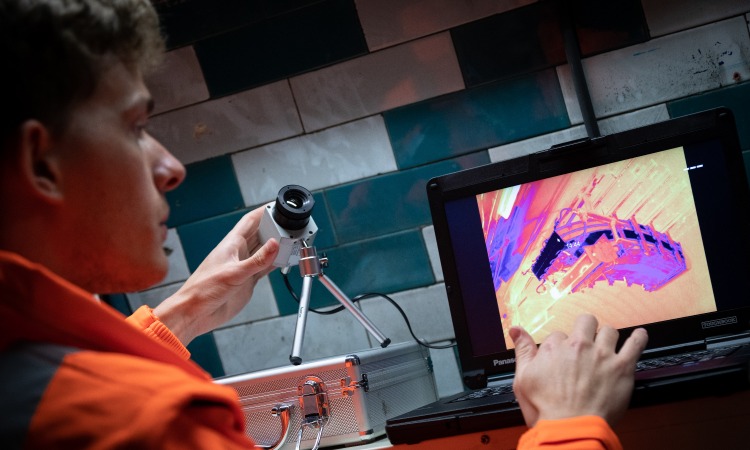TfL trials cooling solution designed to reduce temperatures on Tube network
- Like
- Digg
- Del
- Tumblr
- VKontakte
- Buffer
- Love This
- Odnoklassniki
- Meneame
- Blogger
- Amazon
- Yahoo Mail
- Gmail
- AOL
- Newsvine
- HackerNews
- Evernote
- MySpace
- Mail.ru
- Viadeo
- Line
- Comments
- Yummly
- SMS
- Viber
- Telegram
- Subscribe
- Skype
- Facebook Messenger
- Kakao
- LiveJournal
- Yammer
- Edgar
- Fintel
- Mix
- Instapaper
- Copy Link
Posted: 25 July 2022 | Intelligent Transport | No comments yet
In addition to providing cooler air to passengers waiting on platforms, TfL’s cooling panel aims to reduce potential temperature increases associated with running an increased number of trains.


Credit: Transport for London - A thermal image of the cooling panel
Transport for London (TfL) has announced that it is now trialling a state-of-the-art cooling panel on a disused platform at Holborn station to test its suitability for reducing temperatures on the deep Tube network – the Bakerloo, Central, Jubilee, Northern, Piccadilly, Victoria and Waterloo & City lines.
TfL’s trial comes as the UK experienced its hottest temperatures on record on 18 and 19 July 2022. The cooling panel aims to provide cooler air to passengers waiting on platforms, as well as mitigating potential temperature increases associated with running an increased number of trains on the Piccadilly line, as part of the line’s future capacity upgrade.
The cooling panel works by circulating cold water around pipework within a curved metal structure to chill it. It then circulates air, using an industrial-sized fan, through gaps in the panel’s structure, which in turn is cooled. The panel could also have the additional benefit of halving operational and maintenance costs, compared to existing technology used to manage temperatures on Tube lines.
The trial is part of the UK government’s TIES Living Lab programme, a collaboration of 25 partners focusing on 10 infrastructure, data research and digital demonstrator projects, of which the cooling panels are one. The cooling panel project has been 70 per cent funded by the Department for Transport and Innovate UK. The convection cooling system has been designed by TfL and developed by SRC Infrastructure, which also managed its build.
Network Rail launches taskforce to improve hot weather resiliency
Following the trial at Holborn station and subject to funding being available, TfL will explore whether the panels could provide a cooling solution for other deep Tube lines in the future. Further testing would need to take place in a station open to customers (Knightsbridge) before TfL could look to potentially introduce them at four additional stations on the Piccadilly line (Green Park, Holborn, Leicester Square and Piccadilly Circus). TfL could then identify other locations where the panels could provide a benefit. Progressing this trial at other locations would ultimately be subject to TfL having sufficient long-term capital funding available.
The Piccadilly line has been chosen for this trial as when new, air-conditioned trains with walk-through carriages are introduced to the line from 2025, the current fleet will be gradually withdrawn from service and the frequency of trains in peak hours will rise from 24 to 27 trains per hour from mid-2027. Although currently unfunded, line-wide re-signalling would enable TfL to increase train frequencies on the Piccadilly line to 33 and then 36 trains per hour. It is at this point that additional cooling at five Piccadilly line stations would be necessary, according to TfL’s modelling.
In the past it has been challenging to lower temperatures on the deep Tube lines, as traditional cooling systems have proved prohibitively expensive and difficult to install within the 120-year-old tunnels and stations. In recent tests on a prototype cooling panel in a lab environment, an air temperature reduction of 10-15 degrees in the vicinity of the panel was achieved. TfL is now keen to see if this can be replicated on the disused platform at Holborn, which mimics the live environment that these panels would operate in.
Paul Judge, TfL’s Project Director for the Piccadilly Line Upgrade, said: “This innovative trial is taking place as we are experiencing record high temperatures. This new technology could play an important role in ensuring we are doing everything we can to protect TfL’s network against future temperature increases, helping to keep staff and customers safe and comfortable.”
Related topics
Infrastructure & Urban Planning, Passenger Experience, Public Transport, Vehicle & Passenger Safety
Related modes
Tube
Related cities
London
Related countries
United Kingdom
Related organisations
Department for Transport, Transport for London (TfL), UK Government
Related people
Paul Judge








